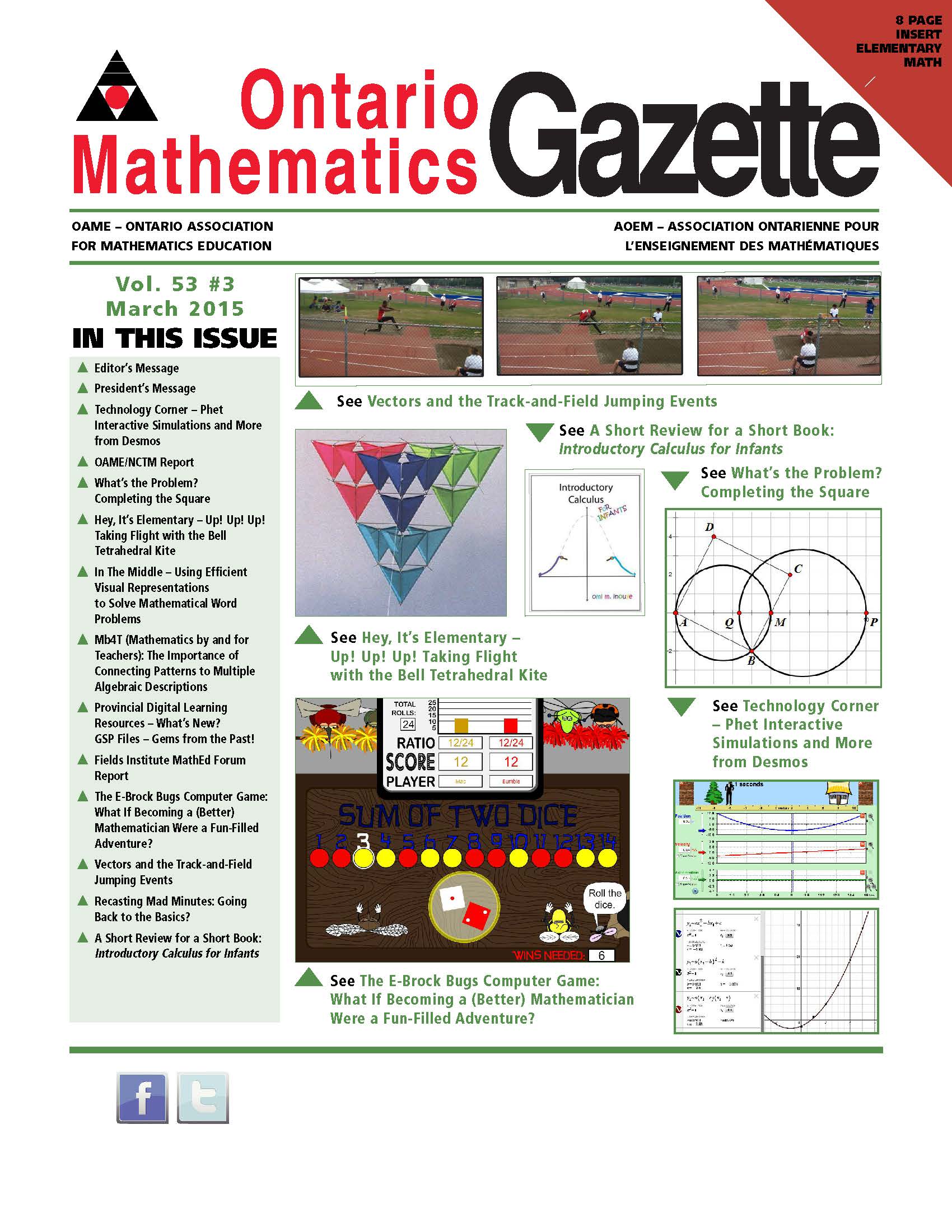
In Recasting Mad-Minutes: Going Back to the Basics?, Marc Husband and Tina Rapke share the results of a classroom-based research experiment, in which Grade 4 students were asked to complete “mad-minute” 1×2-digit multiplication questions, some (control group) using traditional algorithms, and others (treatment group) being encouraged to analyze the questions in terms of perceived difficulty level, to use a variety of previously encountered solution strategies as appropriate, and to generate and share their own set of similar questions and solutions with their peers. The results of pre- and post-tests written by each group are discussed, as are implications for teaching in light of the Ontario Curriculum.
In their article, The E-Brock Bugs Computer Game: What If Becoming a (Better) Mathematician Was a Fun-Filled Adventure?, co-authors Laura Broley, Chantal Buteau, and Eric Muller lead us through a bug’s-eye view of the recently released (2013) digital version of an intriguing educational board game that was originally developed at Brock University back in the 1980s, and that has been successfully used to help elementary and secondary (MDM4U, in particular) students explore the major concepts of probability. Join narrator Bumble the Bee as she encounters helpful friends Bugzy and Smarty, as well as the evil gang of Mac, Bash, Fitz, Trickz, Crazee, Wicked, and the ultimate mastermind, “Dr. P,” and attempts to free the six districts of Bug City. A project website featuring the free game download, teacher resources, media coverage, and related publications is also shared.
Finally, in Vectors and the Track and Field Jumping Events, author Patrick Russell explains how vectors (arrows that describe direction and magnitude of an object in motion) are applied in the various track-and-field jumping events: long jump, triple jump, high jump, and pole vault.
Regular columns include the following highlights: OAME President, Paul Alves (President’s Message) introduces us to Daniel Kish, The Batman, and elaborates on the related importance of appropriately high teacher expectations, growth mindsets, and the fostering of challenging learning opportunities for our students; Todd Romiens (OAME/NCTM Report) discusses three NCTM websites—Illuminations, Figure This, and Reflections; Stewart Craven (Fields Institute Report) reports on the five speakers involved in the Annual Research Day (Jan. 31, 2015) of the MathEd Forum; Mary Bourassa (Technology Corner) highlights PhET interactive simulations, and revisits the open-source software, Desmos; Shawn Godin (What’s the Problem?) poses a problem regarding completing the square; Lynda Colgan (Hey, It’s Elementary) takes us up, up, up, and away with her detailed description of the history and construction of the Bell tetrahedral kite; Mirela Ciobanu (In the Middle) looks at using efficient visual representations to solve mathematical word problems; Ann Kajander (MB4T) explores the importance of connecting patterns to multiple algebraic descriptions; and Greg Clarke, Agnes Grafton, Ross Isenegger, and Markus Wolski (Provincial Digital Learning Resources) share some classic Geometer’s Sketchpad (GSP) files, and also provide us with an exciting update regarding their recently released Rekenrek app for desktop and mobile devices.
As usual, this issue also features the rich contribution of ideas for elementary math teaching as found in the Abacus insert, co-edited by Mary Lou Kestell and Kathy Kubota-Zarivnij. Volume 53 Issue 3 also includes two special features: a review by Tim Sibbald of Inouye’s creative new children’s book, Introductory Calculus for Infants (2011); and, the first instalment of a series of research spotlights focusing on current projects, as shared by Ontario mathematics education researchers.
